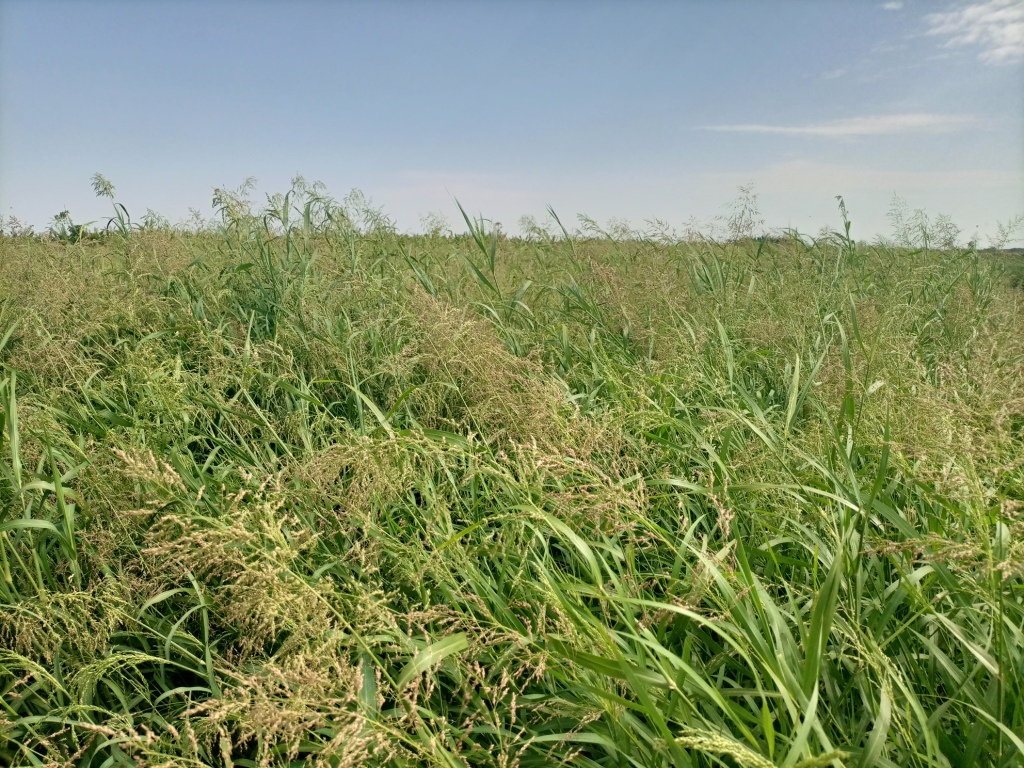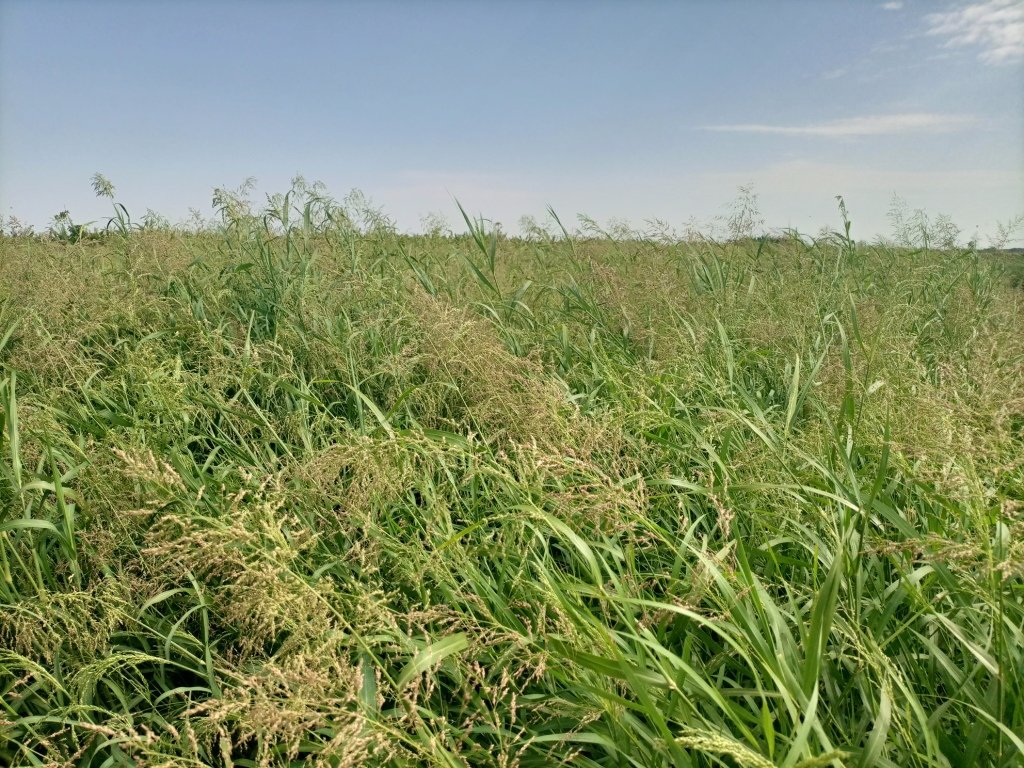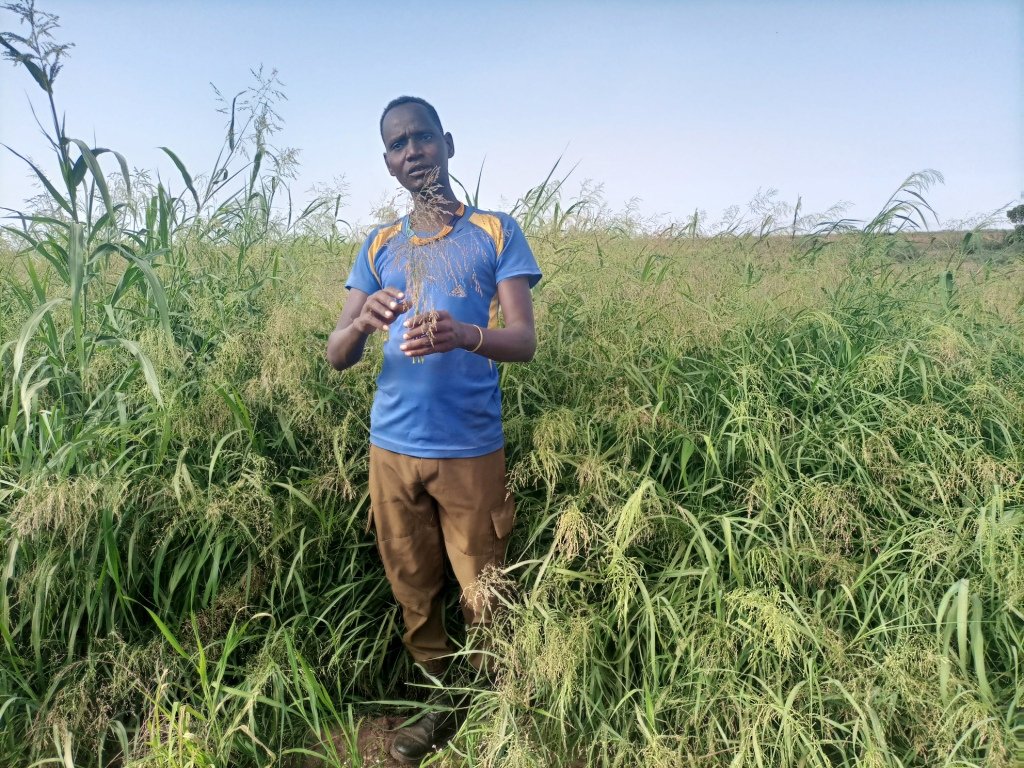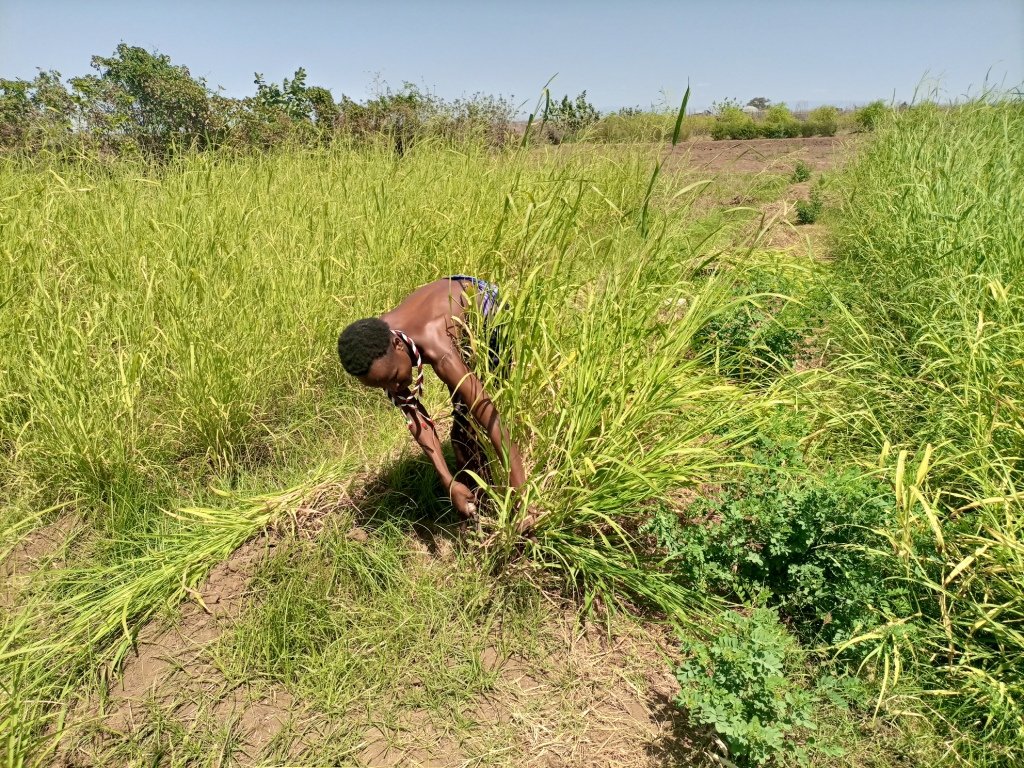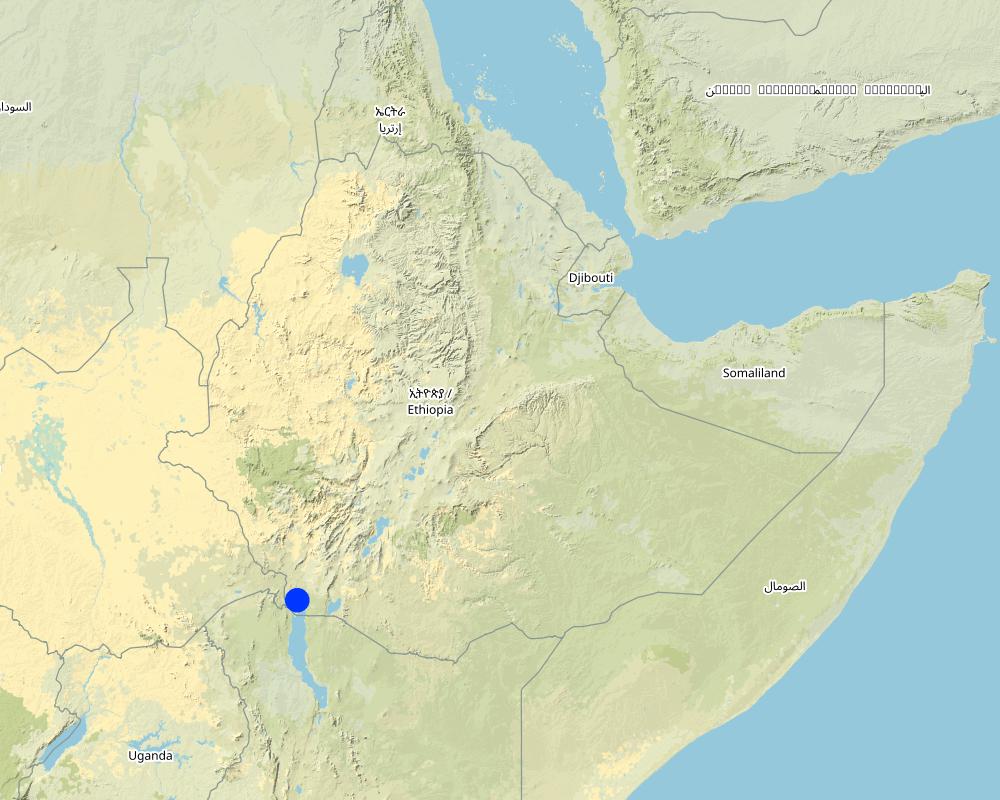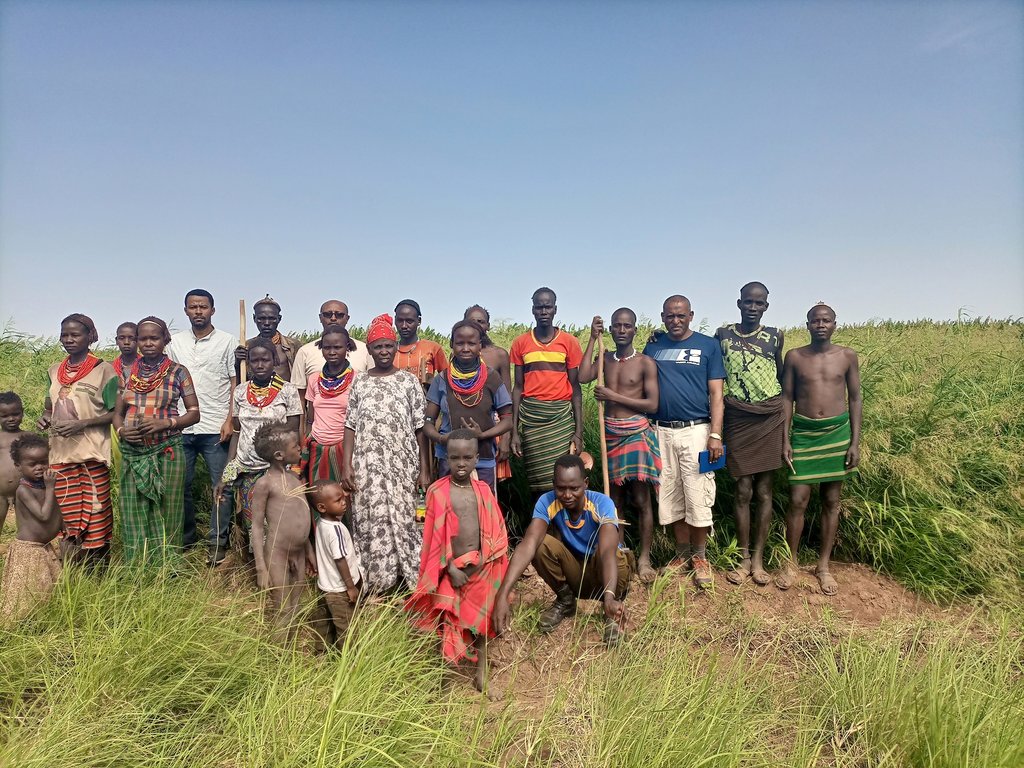Panicum coloratum for irrigated fodder [埃塞俄比亚]
- 创建:
- 更新:
- 编制者: GERBA LETA
- 编辑者: –
- 审查者: William Critchley, Rima Mekdaschi Studer
Panicum
technologies_6563 - 埃塞俄比亚
查看章节
全部展开 全部收起1. 一般信息
1.2 参与该技术评估和文件编制的资源人员和机构的联系方式
关键资源人
土地使用者:
Lutulya Abebe
Agro-pastoralist (fodder producers group leader)
埃塞俄比亚
有助于对技术进行记录/评估的项目名称(如相关)
Resilient in Pastoralist Areas (RIPA)有助于对技术进行记录/评估的机构名称(如相关)
International Development Enterprises - Ethiopia (iDE-Ethiopia) - 美国1.3 关于使用通过WOCAT记录的数据的条件
编制者和关键资源人员接受有关使用通过WOCAT记录数据的条件。:
是
1.4 所述技术的可持续性声明
这里所描述的技术在土地退化方面是否存在问题,导致无法被认为是一种可持续的土地管理技术?:
否
注释:
The technology is a regenerative practice friendly to the environment.
2. SLM技术的说明
2.1 技术简介
技术定义:
Panicum coloratum is a palatable tropical grass with high biomass production potential. It is grown in the irrigated fodder development areas of Dassenech district. Panicum is a fast-growing perennial which can be repeatedly harvested once it reaches maturity. It mitigates the issues of recurrent livestock feed shortage in dry periods – which are becoming worse with climate change.
2.2 技术的详细说明
说明:
Irrigated fodder production is carried out by pastoralist groups in arid areas of South Omo. Among a number of fodder grasses, Panicum coloratum is a fast-growing species. Panicum is grown as livestock fodder, particularly for the dry season when feed availability is in short supply. It mitigates the issues of recurrent livestock feed shortages which are becoming worse with climate change. Also, growing fodder grass allows resource-poor pastoralist communities to generate income from the sale of fresh fodder, hay, and seed. Irrigating at least twice a week, good weed management, and fertilization ensure sustained production.
In Dassenech district of Southwest Ethiopia, Panicum’s annual fresh biomass and dry matter production potential is over 63 and 18 tons/ha, respectively. It can reach its first harvest after about 60 days and subsequently can be harvested every 45 days. Panicum germinates and establishes readily on any soil type under both irrigated and rainfed conditions. It is also drought tolerant and resilient to climate variability, and does particularly well on alluvial soils with high fertility. Panicum is mainly used for grazing, but it is also suitable for cut-and-carry feeding systems. Each member of the pastoralist group grows panicum on 0.04 ha of land. In the flood lowlands of the Omo River basin, panicum is known for tolerating periodic flooding, salinity, & disease.
Previously, the land users were unfamiliar with this particular grass and its associated management practices. Also, irrigating on a regular schedule and keeping the grass free from roaming animals adds a work burden to the pastoralist community. However, the Resilience in Pastoral Areas (RIPA) project has introduced and familiarized the community with fodder production and management practices. The project also assists in linking the output to sustainable market. In this regard, the contribution of the RIPA project of the International Development Enterprises (iDE) is immense. The pastoralists appreciate their livestock’s access to year-round feed, as well as the generation of income from the sale of fresh fodder, hay, and seed. Fodder production also creates year-round employment opportunity. However, the community's reliance on government and civic organization support for land preparation and access to irrigation water (conveyance services) might be considered a threat to ensuring sustainability of fodder development by the pastoralist groups.
2.3 技术照片
2.4 技术视频
注释、简短说明:
Videos of the technology is not documented.
2.5 已应用该技术的、本评估所涵盖的国家/地区/地点
国家:
埃塞俄比亚
区域/州/省:
Southern Nations, Nationalities and People Region (SNNPR).
有关地点的进一步说明:
Omorate, Dassenech.
具体说明该技术的分布:
- 适用于特定场所/集中在较小区域
技术现场是否位于永久保护区?:
否
注释:
Panicum production site is closer to the mouth of the Omo river. The technology is piloted in two sites and scaling up sites have been increasing around the irrigable areas.
Map
×2.6 实施日期
注明实施年份:
2021
2.7 技术介绍
详细说明该技术是如何引入的:
- 通过项目/外部干预
注释(项目类型等):
Resilient Initiatives in Pastoralist Areas project of the International Development Enterprises has implemented fodder development along with other perennial crops such as banana as part of promoting resilient agriculture in the dry areas of South Omo Zone of SNNPRS.
3. SLM技术的分类
3.1 该技术的主要目的
- 改良生产
- 减少、预防、恢复土地退化
- 降低灾害风险
- 适应气候变化/极端天气及其影响
- 创造有益的经济影响
3.2 应用该技术的当前土地利用类型
同一土地单元内混合使用的土地::
否

农田
- 多年一作(非木材)
多年生(非木质)作物 - 指定作物:
- 香蕉/芭蕉/蕉麻
- herbs, chili, capsicum
- natural grasses
每年的生长季节数:
- 2
具体说明:
The area receive bimodal rainfall but not reliable to grow crops.
采用间作制度了吗?:
否
采用轮作制度了吗?:
否

牧场
粗放式放牧:
- 半游牧畜牧业
动物类型:
- 骆驼
- cattle - dairy and beef (e.g. zebu)
- 山羊
- 绵羊
是否实行作物与牲畜的综合管理?:
否
产品和服务:
- economic security, investment prestige
- 奶类
- 外皮/兽皮
品种:
山羊
计数:
12
品种:
cattle - dairy and beef (e.g. zebu)
计数:
8
品种:
骆驼
计数:
1
品种:
绵羊
计数:
9
注释:
The site is pastoralist area who used to rely on flood retreat agriculture in the past. However, due to the construction of Gibe III hydroelectric power dam, the spill over during plenty of rain remain still as artificial lake over thousands of hectare for long period of time. As a result, the conventional agriculture practices abandoned. Thus, a shift to irrigation agriculture is in the process at least to produce fodder crops and other perennial crops such as banana for consumption and market.
3.3 由于技术的实施,土地使用是否发生了变化?
由于技术的实施,土地使用是否发生了变化?:
- 是(请在技术实施前填写以下有关土地利用的问题)
同一土地单元内混合使用的土地::
否

农田
- 多年一作(非木材)
多年生(非木质)作物 - 指定作物:
- 香蕉/芭蕉/蕉麻
- herbs, chili, capsicum
采用间作制度了吗?:
否
采用轮作制度了吗?:
否

牧场
集约放牧/饲料生产:
- 收割和携带/零放牧
- 改良牧场
注释:
The area used to receive short rain twice a year. However, rainfall distribution is unreliable. So, the introduced perennial fodder and banana production persist throughout the year using irrigation.
3.4 供水
该技术所应用土地的供水:
- 充分灌溉
注释:
Fodder and tropical fruit crop production is entirely practiced using full irrigation from Omo river.
3.5 该技术所属的SLM组
- 畜牧业和牧场管理
- 改良的地面/植被覆盖
- 最小的土壤扰动
3.6 包含该技术的可持续土地管理措施

植物措施
- V2:草和多年生草本植物
注释:
Perennial fodder production contributes to SLM through permanent soil cover.
3.7 该技术强调的主要土地退化类型

土壤风蚀
- Ed:风蚀风积

化学性土壤退化
- Cs:盐化/碱化

水质恶化
- Ha:干旱化
注释:
As a perennial crop, the grass covers the ground permanently and reduces moisture loss to excessive evaporation in the dry areas.
3.8 防止、减少或恢复土地退化
具体数量名该技术与土地退化有关的目标:
- 防止土地退化
4. 技术规范、实施活动、投入和成本
4.1 该技术的技术图纸
技术规范(与技术图纸相关):
This is the photo of the pastoralist group. There is no specific sketching that portrays the technology but the following points provide tips for adopters of the technology:
- The land is tilled and harrowed by a tractor for two to three rounds.
- On the third-round ridge and furrow are formed using tractor or hand tools.
- The seeds or splits are planted in rows along the ridge.
- Spacing between ridges varies with the purpose: for haymaking 25 -30 cm and for seed production 50-60 cm to simplify the application of intensive management practice for the latter one.
- The farm/crop should be irrigated twice a week for better production.
- Need Fertilization to ensure good production/harvest.
作者:
Gerba Leta
日期:
19/08/2022
4.2 有关投入和成本计算的一般信息
具体说明成本和投入是如何计算的:
- 每个技术区域
注明尺寸和面积单位:
1 timad
如果使用本地面积单位,注明转换系数为1公顷(例如1公顷=2.47英亩):1公顷=:
0.25 ha
其它/国家货币(具体说明):
Ethiopian Birr (ETB)
如相关,注明美元与当地货币的汇率(例如1美元=79.9巴西雷亚尔):1美元=:
53.438
注明雇用劳工的每日平均工资成本:
It is variable based on the types of work (from 50 birr to 100) for half day before the sun gets too hot. That is equivalent to one day in dry lowland areas.
4.3 技术建立活动
| 活动 | 时间(季度) | |
|---|---|---|
| 1. | Clearing and land preparation | Any season for irrigated fodder production, |
| 2. | Planting/sowing | During the start of season for irrigation fodder production. |
| 3. | Fertilizing | At planting and at boot height. |
| 4. | Irrigating the farm | Twice a week. |
| 5. | Weeding | Twice starting 3- 4 weeks post planting. |
| 6. | Harvesting the grass (fodder) | During harvest maturity. |
| 7. | Hay making (bailing) | Post harvest. |
| 8. | Seed collection, drying and cleaning | Harvesting season and post harvest. |
注释:
As fodder development is based on irrigation, it can be started any time/season of the year.
4.4 技术建立所需要的费用和投入
| 对投入进行具体说明 | 单位 | 数量 | 单位成本 | 每项投入的总成本 | 土地使用者承担的成本% | |
|---|---|---|---|---|---|---|
| 劳动力 | Clearing and land preparation | PDs | 12.0 | 200.0 | 2400.0 | 50.0 |
| 劳动力 | Planting/sowing | PDs | 5.0 | 100.0 | 500.0 | 100.0 |
| 劳动力 | Irrigating the farm | PDs | 14.0 | 200.0 | 2800.0 | 100.0 |
| 劳动力 | Weeding (twice a season) | PDs | 10.0 | 100.0 | 1000.0 | 100.0 |
| 设备 | Spade | Pcs | 1.0 | 500.0 | 500.0 | |
| 设备 | Hoes | Pcs | 1.0 | 300.0 | 300.0 | |
| 植物材料 | Seed | kg | 4.0 | 300.0 | 1200.0 | |
| 肥料和杀菌剂 | NSP | kg | 50.0 | 50.0 | 2500.0 | |
| 其它 | Seed collection, drying and cleaning | PDs | 10.0 | 200.0 | 2000.0 | 100.0 |
| 其它 | Harvesting and hay making | PDs | 10.0 | 200.0 | 2000.0 | 100.0 |
| 技术建立所需总成本 | 15200.0 | |||||
| 技术建立总成本,美元 | 284.44 | |||||
如果土地使用者负担的费用少于100%,请注明由谁负担其余费用:
Other than cost of labor, some inputs and material costs are covered by the RIPA project of the iDE.
注释:
Irrigation-based fodder development is in the pilot phase. There is growing interest among the government organization (Woreda Office of Agriculture) to adopt and scale up the promising development. Please note, the cost is estimated only for a season or one round of production. Once reaches its first harvest, Panicum can be harvested every other 45 days onward. Of course, it needs the application of necessary management practices, every season.
4.5 维护/经常性活动
| 活动 | 时间/频率 | |
|---|---|---|
| 1. | Cleaning irrigation ditch | During off-season or before the start of next growing season. |
| 2. | Fertilizer (NSP) | Twice: at the beginning of the season & when the fodder reaches boots height. |
| 3. | Irrigating the farm | Twice a week. |
| 4. | Weeding (2x) | Based on the density or prevalence of weeds. |
| 5. | Seed collection, drying and cleaning | When the seed reaches harvest maturity. |
| 6. | Harvesting and hay making | At harvest and post harvest. |
注释:
As there is no structure such as fodder banks, maintenance cost is not documented.
4.6 维护/经常性活动所需要的费用和投入(每年)
| 对投入进行具体说明 | 单位 | 数量 | 单位成本 | 每项投入的总成本 | 土地使用者承担的成本% | |
|---|---|---|---|---|---|---|
| 劳动力 | Cleaning irrigation ditch | PDs | 5.0 | 200.0 | 1000.0 | 100.0 |
| 劳动力 | Irrigating the farm | PDs | 12.0 | 200.0 | 2400.0 | 100.0 |
| 劳动力 | Weeding (at least twice during the growing season) | PDs | 10.0 | 100.0 | 1000.0 | 100.0 |
| 劳动力 | Seed collection, drying and cleaning | PDs | 10.0 | 200.0 | 2000.0 | 100.0 |
| 设备 | Harvesting and hay making | PDs | 10.0 | 200.0 | 2000.0 | 100.0 |
| 肥料和杀菌剂 | NSP Fertilizers | kg | 50.0 | 50.0 | 2500.0 | 100.0 |
| 技术维护所需总成本 | 10900.0 | |||||
| 技术维护总成本,美元 | 203.97 | |||||
如果土地使用者负担的费用少于100%,请注明由谁负担其余费用:
NA
注释:
The cost estimation is only for one irrigation season that may range from 45 days to 60 days or some more including the harvesting and drying of the outputs. Once established, the cost of production is gradually declining.
4.7 影响成本的最重要因素
描述影响成本的最决定性因素:
Economic crisis and increasing Inflation rate affect the establishment as well as maintenance costs. Particularly, fuel, fertilizer, and labor costs are consistently changing.
5. 自然和人文环境
5.1 气候
年降雨量
- < 250毫米
- 251-500毫米
- 501-750毫米
- 751-1,000毫米
- 1,001-1,500毫米
- 1,501-2,000毫米
- 2,001-3,000毫米
- 3,001-4,000毫米
- > 4,000毫米
有关降雨的规范/注释:
Erratic and unpredictable.
农业气候带
- 半干旱
Rainfall distribution is unreliable to produce crops under rainfed conditions.
5.2 地形
平均坡度:
- 水平(0-2%)
- 缓降(3-5%)
- 平缓(6-10%)
- 滚坡(11-15%)
- 崎岖(16-30%)
- 陡峭(31-60%)
- 非常陡峭(>60%)
地形:
- 高原/平原
- 山脊
- 山坡
- 山地斜坡
- 麓坡
- 谷底
垂直分布带:
- 0-100 m a.s.l.
- 101-500 m a.s.l.
- 501-1,000 m a.s.l.
- 1,001-1,500 m a.s.l.
- 1,501-2,000 m a.s.l.
- 2,001-2,500 m a.s.l.
- 2,501-3,000 m a.s.l.
- 3,001-4,000 m a.s.l.
- > 4,000 m a.s.l.
说明该技术是否专门应用于:
- 不相关
关于地形的注释和进一步规范:
The site is in the lowland around the mouth of Omo River basin.
5.3 土壤
平均土层深度:
- 非常浅(0-20厘米)
- 浅(21-50厘米)
- 中等深度(51-80厘米)
- 深(81-120厘米)
- 非常深(> 120厘米)
土壤质地(表土):
- 中粒(壤土、粉土)
土壤质地(地表以下> 20厘米):
- 中粒(壤土、粉土)
表土有机质:
- 中(1-3%)
如有可能,附上完整的土壤描述或具体说明可用的信息,例如土壤类型、土壤酸碱度、阳离子交换能力、氮、盐度等。:
Soil pH is over 7 and the soil is slightly saline alluvial.
5.4 水资源可用性和质量
地下水位表:
> 50米
地表水的可用性:
匮乏/没有
水质(未处理):
仅供农业使用(灌溉)
水质请参考::
地表水
水的盐度有问题吗?:
否
该区域正在发生洪水吗?:
是
规律性:
偶然
关于水质和水量的注释和进一步规范:
Diversion/river water is used for irrigation. There is ample water provide that there is pump to convey the water to the nearby farm. In the rainy season, the river is turbid and full of eroded soil from the upstream catchments. However, the depth of the water table is variable based on the distance of the farm from the edge of the river. Around the main river basin, the water table is shallow but too deep as one go away from the river basin.
5.5 生物多样性
物种多样性:
- 低
栖息地多样性:
- 低
关于生物多样性的注释和进一步规范:
Around the farmland, diversity of crops and vegetation is limited. Away from the farmland, there are a few lowland shrub species and faunas common to the dryland.
5.6 应用该技术的土地使用者的特征
定栖或游牧:
- 半游牧的
生产系统的市场定位:
- 生计(自给)
非农收入:
- 低于全部收入的10%
相对财富水平:
- 贫瘠
个人或集体:
- 团体/社区
机械化水平:
- 手工作业
- 机械化/电动
性别:
- 男人
土地使用者的年龄:
- 中年人
说明土地使用者的其他有关特征:
The water pump is used to convey water and the tractor for land preparation. Therefore, a mix of mechanization and manual systems are employed in the area. Irrigation land was allocated to the group but they partitioned and distributed to each member of the group.
5.7 应用该技术的土地使用者使用的平均土地面积
- < 0.5 公顷
- 0.5-1 公顷
- 1-2 公顷
- 2-5公顷
- 5-15公顷
- 15-50公顷
- 50-100公顷
- 100-500公顷
- 500-1,000公顷
- 1,000-10,000公顷
- > 10,000公顷
这被认为是小规模、中规模还是大规模的(参照当地实际情况)?:
- 小规模的
注释:
As their animal is freely roaming, only small size of land is permantantly owned around the river side and homestead.
5.8 土地所有权、土地使用权和水使用权
土地所有权:
- 团体
- 个人,未命名
土地使用权:
- 社区(有组织)
- 个人
用水权:
- 自由进入(无组织)
土地使用权是否基于传统的法律制度?:
是
具体说明:
The pastoralist, still freely move and settle where they think appropriate and shift after certain years.
注释:
Apart from the irrigable land which are located around the river basin, land is openly accessible to the pastoralist community.
5.9 进入服务和基础设施的通道
健康:
- 贫瘠
- 适度的
- 好
教育:
- 贫瘠
- 适度的
- 好
技术援助:
- 贫瘠
- 适度的
- 好
就业(例如非农):
- 贫瘠
- 适度的
- 好
市场:
- 贫瘠
- 适度的
- 好
能源:
- 贫瘠
- 适度的
- 好
道路和交通:
- 贫瘠
- 适度的
- 好
饮用水和卫生设施:
- 贫瘠
- 适度的
- 好
金融服务:
- 贫瘠
- 适度的
- 好
注释:
Access to facility and the services is mainly to those pastoralist community who are residing closer to the Omorate, the woreda capital.
6. 影响和结论性说明
6.1 该技术的现场影响
社会经济效应
生产
饲料生产
注释/具体说明:
Access to irrigation water increase the fodder production throughout the year.
饲料质量
注释/具体说明:
As the alluvial soil around the river bank is suitable for Panicum, it increases the quality of fodder.
畜牧生产
注释/具体说明:
Increase in livestock production is related to the availability of feed/fodder.
生产故障风险
注释/具体说明:
Access to irrigation water highly reduced risk of production failure.
生产区域
SLM之前的数量:
-1
SLM之后的数量:
2
注释/具体说明:
The land that used to be ideal is now converted to farming.
土地管理
注释/具体说明:
Panicum as perennial fodder increases ground cover throughout the year and contributes to land management from wind erosion in the dry land areas.
水资源可用性和质量
饮用水的可用性
SLM之前的数量:
-3
SLM之后的数量:
1
家畜用水的可用性
SLM之前的数量:
0
SLM之后的数量:
0
家畜用水的质量
SLM之前的数量:
0
SLM之后的数量:
0
灌溉用水的可用性
SLM之前的数量:
0
SLM之后的数量:
0
灌溉用水的质量
SLM之前的数量:
0
SLM之后的数量:
0
灌溉用水需求
SLM之前的数量:
0
SLM之后的数量:
-1
收入和成本
农业收入
注释/具体说明:
As Panicum is harvested at least six times a year post reaching the first maturity, farm income is significantly increases.
收入来源的多样性
注释/具体说明:
Income can be generated from the sale of fresh fodder, hay and seeds.
经济差异
SLM之前的数量:
-2
SLM之后的数量:
0
工作量
注释/具体说明:
Irrigated fodder production needs intensive management practices. Panicum is perennial fodder that remain on the field all year round. So, irrigating, weeding and looking after the farm... increases the workload.
社会文化影响
食品安全/自给自足
SLM之前的数量:
-1
SLM之后的数量:
2
健康状况
SLM之前的数量:
-1
SLM之后的数量:
1
土地使用权/用水权
SLM之前的数量:
0
SLM之后的数量:
0
文化机会
SLM之前的数量:
0
SLM之后的数量:
1
娱乐机会
SLM之前的数量:
0
SLM之后的数量:
0
社区机构
SLM之前的数量:
-2
SLM之后的数量:
2
国家机构
SLM之前的数量:
0
SLM之后的数量:
0
SLM/土地退化知识
SLM之前的数量:
-2
SLM之后的数量:
2
冲突缓解
SLM之前的数量:
0
SLM之后的数量:
2
社会经济弱势群体的情况
SLM之前的数量:
-2
SLM之后的数量:
1
生态影响
水循环/径流
地表径流
注释/具体说明:
As it permanently covers the ground, it has high likelihoods of reducing surface runoff.
多余水的排放
注释/具体说明:
Improve water drainage.
蒸发
注释/具体说明:
Decreases surface evaporation but not transpiration.
生物多样性:植被、动物
植被覆盖
注释/具体说明:
The farm remains covered by perennial grass. Irrigating the farm also favor the regrowth of other wild species.
生物量/地上C
注释/具体说明:
Above ground biomass is highly increased as described in the description section.
植物多样性
外来入侵物种
注释/具体说明:
Reduced with increased management practices. Invasive alien species such as Prosopis juliflora is less common in this part of the River basin.
动物多样性
注释/具体说明:
Animal diversity correlates with fodder availability.
有益物种
栖息地多样性
害虫/疾病控制
减少气候和灾害风险
洪水影响
干旱影响
注释/具体说明:
It reduces the impacts of drought on livestock by providing access to adequate feeds throughout the year.
碳和温室气体的排放
注释/具体说明:
As Panicum increase ground cover and store the carbon above and below the soil surface, it reduces the emission of the carbon.
风速
注释/具体说明:
It breaks the velocity of wind in the lowland, one of the main issues.
微气候
注释/具体说明:
Slightly ameliorate the micro-climate of the area.
6.2 该技术的场外影响已经显现
水资源可用性
SLM之前的数量:
0
SLM之后的数量:
0
旱季稳定可靠的水流
SLM之前的数量:
0
SLM之后的数量:
0
下游洪水
注释/具体说明:
It is expected that downstream flooding is reduced as the perennial fodder crop cover the ground throughout the year.
下游淤积
SLM之前的数量:
-3
SLM之后的数量:
0
地下水/河流污染
SLM之前的数量:
-1
SLM之后的数量:
0
缓冲/过滤能力
注释/具体说明:
Permanent ground cover expected to increase the filtering capacity.
风力搬运沉积物
注释/具体说明:
It has expected positive effects of reducing wind transportation.
对邻近农田的破坏
对公共/私人基础设施的破坏
温室气体的影响
注释/具体说明:
As perennial crops cover the ground and absorb the carbon, it has an inevitable positive effects on reducing carbon emission.
对场外影响(测量)的评估进行具体说明:
The fodder development is a pilot practice. Its up scaling will have a positive off-site effects to the surrounding areas.
6.3 技术对渐变气候以及与气候相关的极端情况/灾害的暴露和敏感性(土地使用者认为的极端情况/灾害)
渐变气候
渐变气候
| 季节 | 增加或减少 | 该技术是如何应对的? | |
|---|---|---|---|
| 年温度 | 增加 | 适度 | |
| 年降雨量 | 减少 | 好 |
气候有关的极端情况(灾害)
气象灾害
| 该技术是如何应对的? | |
|---|---|
| 局地风暴 | 适度 |
气候灾害
| 该技术是如何应对的? | |
|---|---|
| 热浪 | 适度 |
| 干旱 | 好 |
水文灾害
| 该技术是如何应对的? | |
|---|---|
| 比较和缓的(河道)洪水 | 非常好 |
| 山洪暴发 | 好 |
生物灾害
| 该技术是如何应对的? | |
|---|---|
| 流行病 | 好 |
| 昆虫/蠕虫侵扰 | 好 |
注释:
Panicum has drought, flood and disease tolerating feature.
6.4 成本效益分析
技术收益与技术建立成本相比如何(从土地使用者的角度看)?
短期回报:
稍微积极
长期回报:
积极
技术收益与技术维护成本/经常性成本相比如何(从土地使用者的角度看)?
短期回报:
积极
长期回报:
非常积极
注释:
The technology was piloted two years ago. The cost of establishing it is partly supported by the RIPA project. Land preparation and conveying irrigation water covered by the local government.
6.5 技术采用
- 单例/实验
注释:
So far, the pastoralist piloted the technology through government and NGO support.
6.6 适应
最近是否对该技术进行了修改以适应不断变化的条件?:
否
6.7 该技术的优点/长处/机会
| 土地使用者眼中的长处/优势/机会 |
|---|
| Supply year round feed for the land users' livestock. |
| Allow pastoralists/agro-pastoralists to generate income from the collection and sale of fresh fodder, hay and seed. |
| The technology supplies feed that can be reserved for the emergency time through hay making. |
| Introduction of fodder production technology enables the pastoralist group access usufructs to irrigable land that promotes the changing in farming practices from entirely pastoralist to agro-pastoralist on a gradual basis. |
| 编制者或其他关键资源人员认为的长处/优势/机会 |
|---|
| The technology considered as one of the regenerative agricultural practices that have positive contribution to carbon sequestration. |
| It reduces risks of feed shortage during the extended dry season. |
| A prompt sources of income for the pastoralist community via the sale of fresh fodder, hay, and seed. |
| Feeding livestock on grass reduces methane production as compared to feeding them on processed feeds. |
| The onsite shattering of the seed increases the density of grass every other season. Thus, it improves the ground cover and production of huge biomass per unit of land. |
| Panicum harvested 15 cm high that simplify regrowth/tillering and propagation of the grass from the ratoon. The practice stimulates prompt ground cover and year-round sequestration of carbon. |
6.8 技术的弱点/缺点/风险及其克服方法
| 土地使用者认为的弱点/缺点/风险 | 如何克服它们? |
|---|---|
| Access to irrigation facility and service is via government and project support. | Try to secure multiple sources of finance, and encourage market oriented production to enhance the pastoralist groups develop reliance on their own. |
| Smaller size of land is accessible to irrigation. | Increase intensification of fodder development and diversify sources of income via production and marketing of fresh fodder, hay, and the seed. |
| Shortage of baling machine to fasten the hay for simplicity of storage and transportation | Improve pastoralist access to the facility and services so that their resilience to feed shortage and associated issues are promptly increases. |
| 编制者或其他关键资源人员认为的弱点/缺点/风险 | 如何克服它们? |
|---|---|
| Shortage of storage structure or fodder bank to store/ reserve the harvest for market and/or later uses. | To promote the establishment of storage or fodder bank by the land users group themselves, and try to find sources of finance to support them in this regard. |
| Lack of sustainable market links for Panicum seed. | Establish reliable market value chain with private suppliers/distributors to the other part of the country. |
| Lack of legume fodder species to improve the dietary value of the grass family. | Introduces important legume species with high biomass production potential or other leguminous tree species with multiple uses such as windbreak or as buffer plants around the periphery of the fodder farm. |
| Panicum needs longer time to reach harvest if intended for seed production that may dishearten the pastoralist to wait longer time. | Allocate separate plots for seed production, or else, make the right choice for the types of outputs that suits the pastoralist's urgent needs. |
7. 参考和链接
7.1 信息的方法/来源
- 实地考察、实地调查
Over 20 members of the pastoralists group are met.
- 与土地使用者的访谈
One knowledgeable land user who is representative of the pastoralists group.
- 与SLM专业人员/专家的访谈
Three
- 根据报告和其他现有文档进行编译
Published articles and locally developed guideline for growing Panicum.
(现场)数据是什么时候汇编的?:
20/08/2022
注释:
Field visit was made from 17 August to 19, 2022.
7.2 参考可用出版物
标题、作者、年份、ISBN:
ILRI. 2013. Colored Guinea grass (Panicum coloratum) for livestock feed on small-scale farm. ILRI Forage Factsheet.
可以从哪里获得?成本如何?
Free online
标题、作者、年份、ISBN:
Hidosa, D., Hitiso, W. & Guyo, M. 2017. Biomass Production of different grass species available at irrigated lowland of Dassench woreda in Southwestern Ethiopia. Bangladesh Journal of Animal Science, 46 (3): 188-191.
可以从哪里获得?成本如何?
Free online
标题、作者、年份、ISBN:
Hidosa, D., Adicha, A., Sultan, M., 2022. Production and Commercialization Status of Improved Panicum Grass Cultivation in the Lowland Livestock Production System of South Omo South-Western Ethiopia. Research on World Agricultural Economy, 3 (4): 694. DOI:10.36956/rwae.v3i4.694
可以从哪里获得?成本如何?
Free online
7.3 链接到网络上的相关信息
标题/说明:
Tropical Forage. 2020. Panicum coloratum
URL:
https://www.tropicalforages.info/text/entities/panicum_coloratum.htm
7.4 一般注释
The questionnaire is very comprehensive and inclusive to socio-economic and environmental benefits, and the effects of a specific SLM technology.
链接和模块
全部展开 全部收起链接
无链接
模块
无模块


